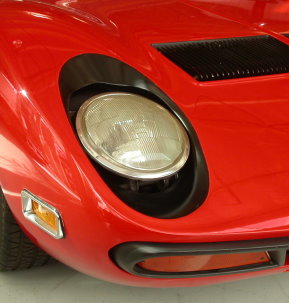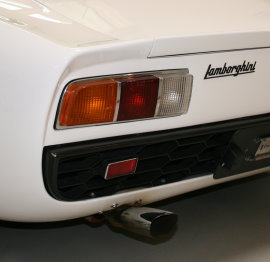The SV
The SV (Spinto Veloce - Pushed Fast) was the ultimate evolution of the (production) Miuras. It is the most refined and best-handling of the three versions. Most records show 150 SVs made between 1971 and the end of the production in 1972 although it appears some production continued into 1973.
One Miura SV was reportedly delivered to its owner, Walter Wolf, as late as 1975. The story is that Wolf convinced Lamborghini to build a Miura for him from available parts (chassis 5092). Joe Sackey is a huge Miura fan, has owned several SVs and organized the 2000 Miura 30th Reunion in Monterey. According to Sackey, 5092 was finished in January 1973 for Lebanese ambassador Harry Lannsberg, who drove it in Paris on Diplomatic plates. However as soon as Lannsberg's SVJ (5100) was ready he returned 5092 to the factory. Over the next year or two the factory did some special work on the car for Wolf. He didn't take delivery of it until April 1975.
Updates for the SV are:
- The "eyelashes" were removed and the space was filled in with metal and painted black to retain the image. I have seen one SV that had eyelashes. The owner claimed it was a special order from the factory. This is entirely possible. The same car had a steering wheel lock that I have never seen on any other Miura. Again, claimed to be factory-installed.

- The rear lower suspension was changed from an inverted A-arm with a trailing link to regular A-arm (with the base of the A on the frame, instead of the top of the A).
- The half-shafts were lengthened due to the update lower control arm's increased length.
- The rear wheels were changed from 7" width to 9" width and the rear clip was widened to cover them.
- The front bumper was changed to accommodate different turn-signal indicators.
- The taillights were changed.

- Some of the later SVs had the engine and transmission oil seperated.
- The transmissions in cars that had the sump seperation was changed from a ZN to a ZF (or the other way around - I'll have to check).
- The gas cap changed from one that closed with a half turn, to a screw-down cap. This may have only been for US cars.
- The chassis around the front of the engine had extra ducts to direct air to the engine for improved cooling.
- The carburetters were changed from the Weber 40IDL3C used in the P400 and S, to the 40IDL3L.
- The ignition key/switch was moved from the center console to the steering column and included a steering wheel lock.
- Some sections of the frame were made without lightening holes. Specifically at the front suspension and around the rear of the engine cradle.
Sackey adds the following information:
The 614th car (chassis 4834) was the first production SV. A total of 52 SVs including 4834 were originally built with the same common engine lubrication as all previous Miuras. Starting with the 666th car (chassis 4960) the factory split the engine and transmission sumps. There were 96 factory split-sump cars built, for a total of 148 production Miura SVs. Of these 148, one was the Jota (5084) and five were converted into SVJ's by the factory. The last US production car was chassis 5064, once owned by Sackey. The car was immaculately restored at Bobileff Motors, and is now a beautiful lime green with a blue interior.
Sackey also once owned a car that had originally belonged to the Shah of Iran. He has an original Miura register put together by Sgarzi/Pussich in Lamborghini's sales dept. It shows 4 Miura SVs and 1 SVJ were completed in 1973, the last being in October of that year. He published this in his book The Lamborghini Miura Bible. (See Books, at the end of the list.)
Rear Suspension
The most significant change in the SV was to the lower rear suspension. The inverted A arms and trailing links of the P400 and S were replaced with the same control arm being used on the Espada and Jarama S. (Some changes to the arm were made for the SV, but it is basically the same part.) The new arm is about 1.5" longer than the old inverted A. The upper suspension arms didn't change, but because the lower part of the wheel carrier was now 1.5" further from the frame, the upper suspension had to be mounted 1.5" further out to keep the wheel carrier upright. In addition, the rear wheels on the SV went from 7" to 9" wide, with all 2" added to the outside of the wheel. (The track, measured from tire center to tire center, increased by 5" total.) The added 3.5" per side wouldn't fit under the rear wheel wells, so wider fenders were installed. The difference is very obvious. The sides of the P400 and S are fairly straight for the length of the car. On the SV, the rear clip flares immediately where it meets the body.
Click to see comparison measurements of the P400 and SV frames.



